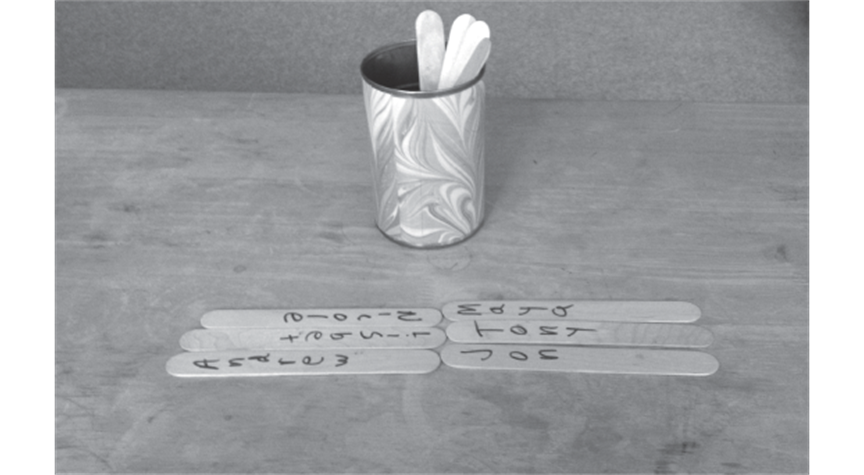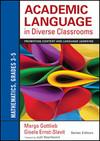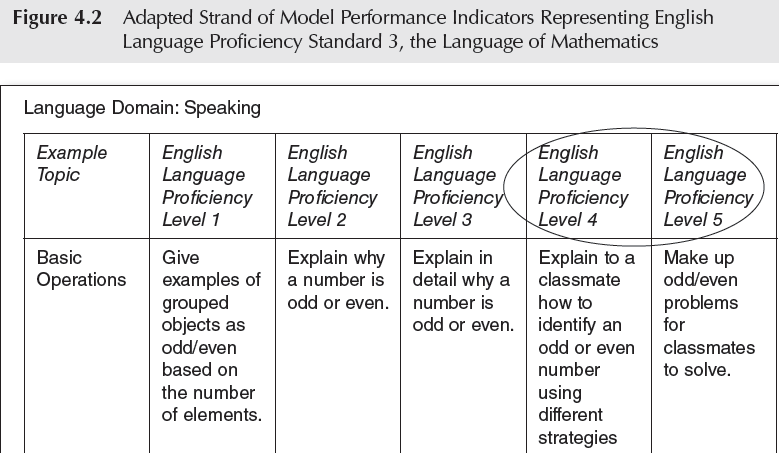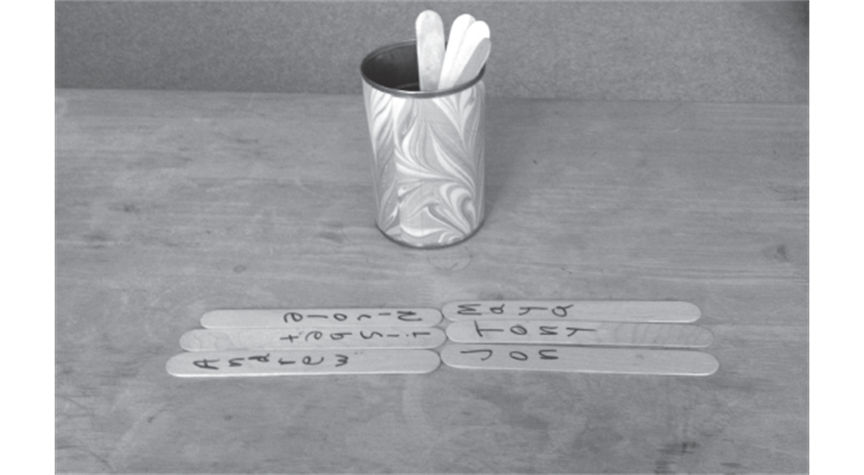The Academic Language of Mathematics
 In last week's mail, I presented some considerations for implementing the CCSS for Mathematics when instructing English learners. In this week's mail, I want to follow up with a discussion of the role of academic language in that instruction. First, I will set the phase by sharing one skillful's view of bookish language for ELLs. Adjacent, I will introduce you lot to a new book serial from Corwin that focuses on theory too as practical ideas for teaching ELLs the bookish language of mathematics and English language arts. Finally, I'll showcase some practical examples for teaching mathematics to ELLs in course 2 from 1 of the book's capacity.
In last week's mail, I presented some considerations for implementing the CCSS for Mathematics when instructing English learners. In this week's mail, I want to follow up with a discussion of the role of academic language in that instruction. First, I will set the phase by sharing one skillful's view of bookish language for ELLs. Adjacent, I will introduce you lot to a new book serial from Corwin that focuses on theory too as practical ideas for teaching ELLs the bookish language of mathematics and English language arts. Finally, I'll showcase some practical examples for teaching mathematics to ELLs in course 2 from 1 of the book's capacity.
One View of Academic Linguistic communication
Dr. Debbie Zacarian is the director of the Heart for English Linguistic communication Education and Advancing Student Achievement at the Collaborative for Educational Services in Northampton, MA and author of Colorín Colorado's policy guide, Serving English Learners: Laws, Policies, and Regulations.
She is a correspondent to the Corwin series listed below and also has her ain new book out about academic language, Mastering Academic Linguistic communication: A Framework for Supporting Student Achievement. She generously shared her insights on the importance of bookish language for ELLs for this postal service:
A common ways for designing programming for ELLs is analyzing their home languages, countries of origin, level of English language development and performance on loftier stakes tests. While this is helpful data, the reality that ELLs are among the lowest performing subgroups in our nation and that a significant number fail or drop out should raise our level of urgency to shine a new low-cal on how we design our programming. Take a wait at the federal definition of English language proficiency:
- The ability to meet the state's skilful level of achievement on state assessments
- The ability to successfully achieve in classrooms where the language of pedagogy is English language; and
- The opportunity to participate fully in society.
These skills and opportunities define academic linguistic communication; however, many ELLs and vernacular speakers of English language do not possess them.
That is, to be successful in schoolhouse and beyond requires students to carry academic language to, in, and from school. How tin we remedy the gap? We have to understand academic language learning equally a four-prong process: a (ane) sociocultural, (2) developmental, (3) academic, and (four) thinking-to-larn process.
Academic Language in Diverse Classrooms Book Series
Academic language is of increasing importance to educators as the Common Core State Standards, the new national anchor for curriculum, instruction, and assessment, have set a loftier bar of rigorous and challenging content, especially for ELLs.
A new seven-book serial edited by Margo Gottlieb and Gisela Ernst-Slavit and published past Corwin presents the evolving theory behind the construct of academic language, a definition and examples of each of its components, and a template for direct classroom applicability. This book series offers guidance to educators in how to target bookish language in planning for student learning as states undergo the implementation of the Common Core and corresponding English language development standards.
seven-book serial edited by Margo Gottlieb and Gisela Ernst-Slavit and published past Corwin presents the evolving theory behind the construct of academic language, a definition and examples of each of its components, and a template for direct classroom applicability. This book series offers guidance to educators in how to target bookish language in planning for student learning as states undergo the implementation of the Common Core and corresponding English language development standards.
The series consists of vi carve up volumes for English Linguistic communication Arts and Mathematics segmented according to grade ring (K-2; 3-5; 6-8). A separate foundational text, entitled Academic Language in Diverse Classrooms: Definitions and Contexts complements the six volumes.
Each of the six books in the content serial provides a detailed, comprehensive treatment of text-based bookish language at each course level and describes the procedure by which teachers can incorporate academic language into their instructional assessment practices. The first two volumes, Academic Language in Diverse Classrooms: Mathematics, Grades M-2 and Academic Linguistic communication in Diverse Classrooms: Mathematics, Grades 3-5 take recently been published, and the remainder of the books will exist published subsequently in 2013.
Mathematics Books Overview
The mathematics books build a curricular framework that integrates language and cultural supports with mathematics content during lesson planning, implementation, and reflection. The aim of the mathematics books is for readers to:
- Understand the role of language within the math principles of the Common Core
- Identify potential obstacles to understanding
- Contain academic language into standards-referenced unit targets and lesson objectives
- Collaborate with ELL specialists to help students admission the curriculum
To that terminate, each grade-specific chapter models the types of interactions and learning experiences that assistance students master both math content and bookish language. (On a side annotation, Dr. Ernst-Slavit and Dr. David Slavit but published an article in Language Magazine titled "Mathematically Speaking" that highlights different aspects of the linguistic communication of mathematics and the fact that mathematics is non a universal linguistic communication.)
Grade Two Examples of the Academic Language of Mathematics
In a chapter of the Grades M-two mathematics book co-authored by 2nd class teacher Michael Silverstone and Debbie Zacarian, readers encounter Mark Zimmerman, a full general second grade instructor whose class of 23 students includes seven current or recently exited ELLs. In one role of the chapter, Mr. Zimmerman teaches a CCSS-based mathematics unit on the concepts of odd and even. He bases his instruction on the following content and language targets:
Content target: Students volition name and sort numbers every bit odd or even.
Language target: Students volition explicate how odd and even numbers are the same and how they are dissimilar.
He uses WIDA's 2012 Distension of the ELD Standards to frame performance indicators for his ELLs at different levels of English language proficiency when speaking virtually the concepts of odd and even.

Mr. Zimmerman has observed that the ELLs and colloquial speakers of English in his class rarely, if ever, participate in grade. To help his students to be active leaders in mathematics, he intentionally secured means for them to empathise and use the mathematics concepts by connecting them with their personal, cultural, social, and world cognition and straight and explicitly teaching them based on their level of English linguistic communication, mathematics, and thinking skill development. He knew that his students were well-versed in choosing two teams and in choosing a partner to work with and decided to build on his students' strengths to teach them virtually odd and even.
To modernistic  el the mathematical concepts of odd and even to ELLs at different levels of English language proficiency, Mr. Zimmerman wrote his students' names on sticks and placed them in a can. He took random handfuls of sticks, and the students decided whether the sticks would divide into two even teams or two nearly even teams with diff totals. He pointed out that an even number of students would make two exactly even teams – or, in an even number of students, everybody could have a partner and no one would be lone or in a group of three. With an odd number of students, in that location would be i student left out or in a group of three.
el the mathematical concepts of odd and even to ELLs at different levels of English language proficiency, Mr. Zimmerman wrote his students' names on sticks and placed them in a can. He took random handfuls of sticks, and the students decided whether the sticks would divide into two even teams or two nearly even teams with diff totals. He pointed out that an even number of students would make two exactly even teams – or, in an even number of students, everybody could have a partner and no one would be lone or in a group of three. With an odd number of students, in that location would be i student left out or in a group of three.
He then had his students use math terminology to offering proof and reasoning. For example, his students responded to questions such as:
- What happens when you add two even numbers? What happens when you add two odd numbers? What happens when you add an fifty-fifty and odd number?
- Is this true for whatever two even numbers? Is it true for whatsoever two odd numbers?
- Explain (or prove) why this is true.
Mr. Zimmerman also gave partners prompts such as "Is this an even or odd number? How practice you know?" He provided judgement starters so his students could answer these questions, such as:
- An odd number has…
- An even number has…
- I know this is an even number considering…
- I know this is an odd number because…
For further discussion, I encourage y'all to take a deeper look at the practical books in this series to fill your toolkit with more ideas for teaching the circuitous academic language of the CCSS to ELLs.
Books on Bookish Linguistic communication
Corwin Series:
- Academic Language in Various Classrooms: Definitions and Contexts
- Academic Language in Diverse Classrooms: Mathematics, Grades K-2
- Academic Language in Various Classrooms: Mathematics, Grades 3-5
Additional books by Debbie Zacarian:
- Mastering Academic Language: A Framework for Supporting Pupil Achievement
- The Essential Guide for Educating Beginning English language Learners (co-authored with Judie Haynes)
- Teaching English language Language Learners Across the Content Areas (co-authored with Judie Haynes)
Colorín Colorado'southward Bookish Linguistic communication Resources
- Bookish Language Resource Section
- How to select vocabulary words for teaching ELLs
- Increasing academic language knowledge
- Linguistic communication objectives for ELL
Colorín Colorado Bookish Linguistic communication Video
- Bookish Language Good Interview: Dr. Cynthia Lundgren, Hamline Academy
- Webcast with Dr. Robin Scarcella: Academic Language and ELLs
Source: https://www.colorincolorado.org/blog/academic-language-mathematics
0 Response to "The Academic Language of Mathematics"
Post a Comment